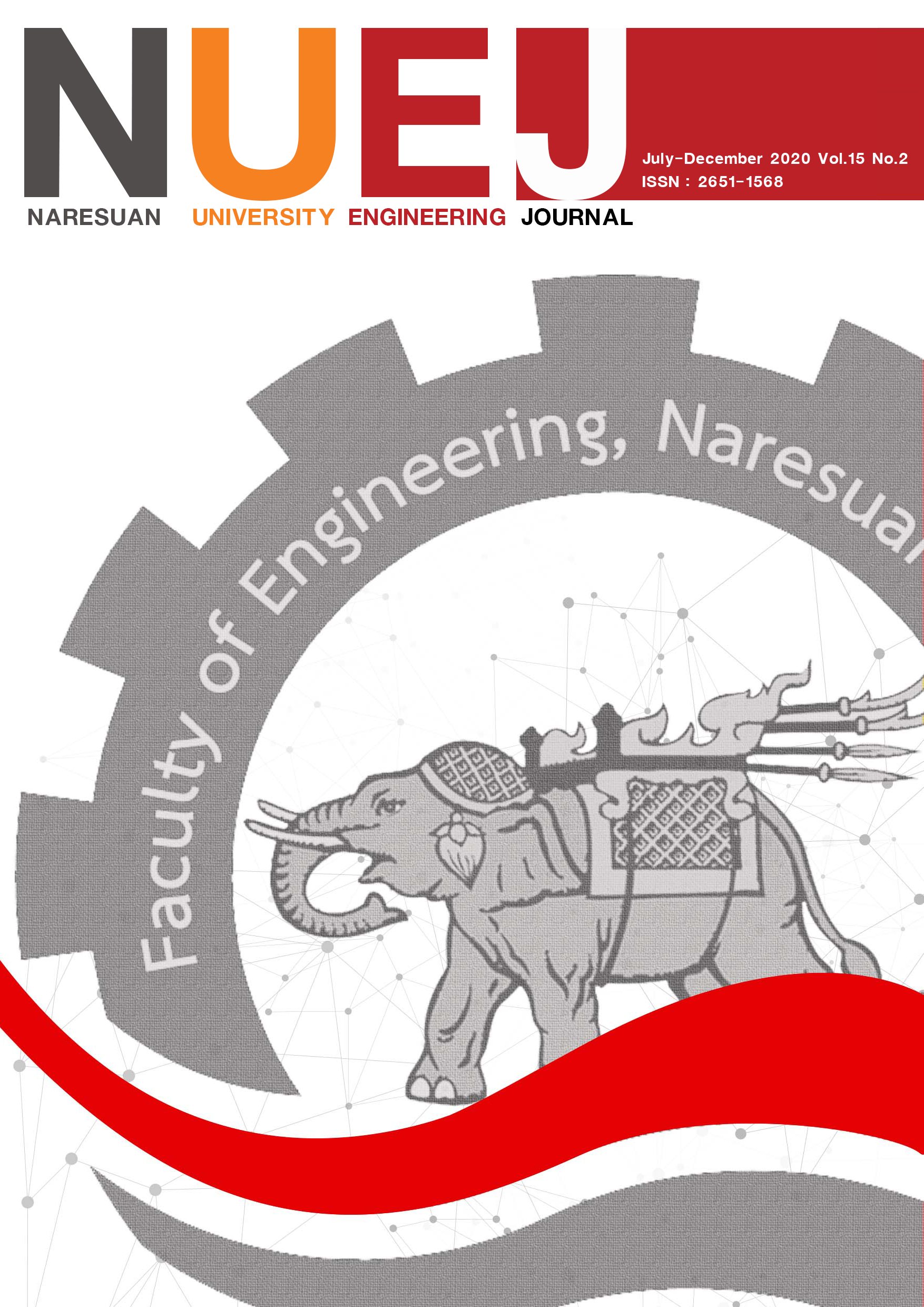การศึกษาเชิงตัวเลขค่าสมรรถนะเชิงสถิตย์ของกังหันลมซาโวเนียสเมื่อติดตั้งช่องทางไหลนำร่องแบบแผ่นโค้งโดยใช้โปรแกรม OpenFOAM
Main Article Content
บทคัดย่อ
งานวิจัยนี้ศึกษาการไหลของกังหันลมซาโวเนียส ที่ตำแหน่งของใบพัด 0°, 30°, 60°, 90°, 120° และ 150° ใช้โปรแกรมสำเร็จรูปทางด้านพลศาสตร์ของไหลเชิงคำนวณ OpenFOAM พิจารณาในรูปแบบสองมิติ โดยสอบเทียบผลการจำลองกับการทดลองจริงที่ค่าเรย์โนลด์นัมเบอร์ เท่ากับ 4.32× 105 โดยมีวัตถุประสงค์ของงานวิจัยเพื่อจำลองการไหลของอากาศ พิจารณาค่าความดันและความเร็วของอากาศที่ใบพัดตำแหน่งต่างๆ นอกจากนั้นงานวิจัยนี้ได้ศึกษาประสิทธิภาพกังหันลมเมื่อมีการติดตั้งช่องทางไหลนำร่องแบบแผ่นโค้ง พบว่าค่าสัมประสิทธิ์แรงบิดเชิงสถิตย์มีค่าสูงขึ้นที่ตำแหน่ง 0°, 30°, 60°, 120° และ 150° เมื่อเทียบกับกังหันลมที่ไม่มีการติดตั้งช่องทางไหลนำร่อง อย่างไรก็ตาม ที่ตำแหน่งใบพัด 90° เป็นตำแหน่งที่ค่าสัมประสิทธิ์แรงบิดลดลง โดยผลการวิเคราะห์ที่ได้จะเป็นตัวแปรที่ใช้ในการออกแบบเพื่อพัฒนากังหันลมให้มีประสิทธิภาพต่อไป
Article Details
References
Altan, B. D., & Atilgan, M. (2010). The use of a curtain design to increase the performance level of a Savonius wind rotors. Renewable Energy, 35, 821-829.
Altan, B. D., Atilgan, M., & Ozdamar, A. (2008). An experimental study on improvement of a Savonius rotor performance with curtaining. Experimental Thermal and Fluid Science 32, 1673-1678.
Anderson, J. D. (1995). Computational Fluid Dynamics: The basics with applications. McGrawHill Book.
Blackwell, B. F., Sheldahl, R. E., & Feltz, L. V. (1977). Wind tunnel performance data for two- and three-bucket Savonius rotors. Sandia Report SAND 76-0131.
Chaiworapuek, W., & Saengswarng, S. (2015). Prediction of Static Performance of Savonius Wind Turbine under the Variation of Wind Velocities. Kasetsart engineering journal, 94(28), 1-10.
Chong, W. T., Poh, S. C., Fazlizan, A., & Pan, K.C. (2012). Vertical axis wind turbine with omni-directional guide vane for urban high-rise buildings. Journal of Central South University, 19, 727-732.
Hayashi, T., Li, Y., & Hara, Y. (2005). Wind tunnel tests on a different phase three-stage Savonius rotor. JSME International Journal Series B Fluids and Thermal Engineering, 48(1), 9-16.
Kacprzak, K., Liskiewicz, G., & Sobczak, K. (2013). Numerical investigation of conventional and modified Savonius wind turbines. Renewable Energy, 60, 578 – 585.
Launder, B. E., & Spalding, D. B. (1972). Lectures in Mathematical models of turbulence. Academic Press.
Loksupapuiboon, K., & Suvanjumrat, C. (2020). Validation of Wall Functions for Two-Equation Turbulence Models of OpenFOAM. The Engineering Institute of Thailand under H.M. The King’s Patronage, 31(2), 105-117.
Menet, J. L., & Rezende, T. D. (2013). Static and dynamic study of a conventional Savonius rotor using a numerical simulation [Paper presentation]. 21è Congrès FranÇais de Mécanique (CFM), Bordeaux, France.
Menter, F. R. (1993). Zonal two equations k- ω turbulence models for aerodynamic flows. AIAA-93-2906.
Mohamed, M. H. (2011). Design optimization of Savonius and wells turbines [Doctoral dissertation]. Otto von Guericke University of Magdeburg. https://d-nb.info/1011710889/34
Mohamed, M. H., Janiga, G., Pap, E., & Thevenin, D. (2011). Optimal blade shape of a modified Savonius turbine using an obstacle shielding the returning blade. Energy Conversion and Management, 52, 236 - 242.
OpenCFD. (2011, August 8). OpenFOAM foundation. http://www.openfoam.com
Roy, S., & Saha, U. K. (2013) Review on the numerical investigations into the design and development of Savonius wind rotors. Renewable Sustainable Energy Rev, 24(2013), 73-83.
Shaheen, M., El-Sayed, M., & Abdallah, S. (2015). Numerical study of two-bucket Savonius wind turbine cluster. Journal of Wind Engineering and Industrial Aerodynamics, 137, 78-89.
Suvanjumrat, C. (2017). Comparison of Turbulence Models for Flow Past NACA0015 Airfoil using OpenFOAM. Engineering Journal, 21(3), 207-221.
Suvanjumrat, C. (2018). Computational Fluid Dynamics of finite volume method. Mahidol University Press.
The Renewable Energy Website (2017, September 9). Savonius Wind Turbines. http://www.reuk.co.uk
Versteeg, H. K., & Malalasekera, W. (2007). Implementation of boundary conditions, An Introduction to Computational Fluid Dynamics: The Finite Volume Method (2nd ed.). Pearson Education Limited.
Versteeg, H. K., & Malalasekera, W. (1995). Introduction to Computational Fluid Dynamics: The Finite Volume Method. John Wiley and Sons.
Wang, H., Wang, J., Yao, J., Yuan, W., & Cao, L. (2012). Analysis on the aerodynamic performance of vertical axis wind turbine subjected to the change of wind velocity. Procedia Engineering, 31, 213-219.
Watson, D. (2017, September 8). Wind Turbines and the Energy in Wind. http://www.ftexploring.com
Wilcox, D. C. (1994). Turbulence energy equation models, in Turbulence Modelling for CFD (2nd ed.). ECW Industries.

